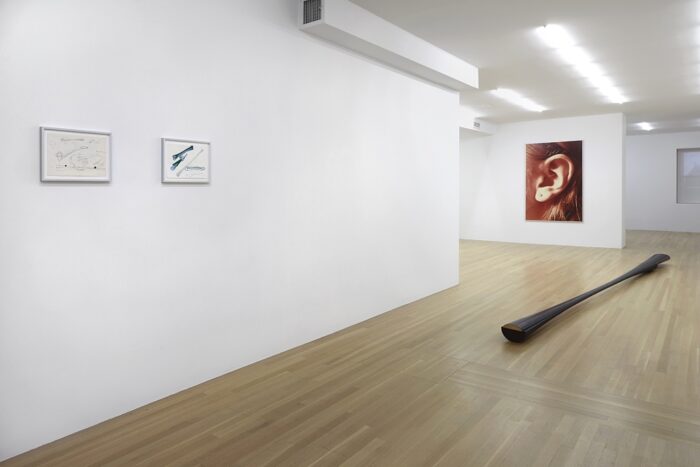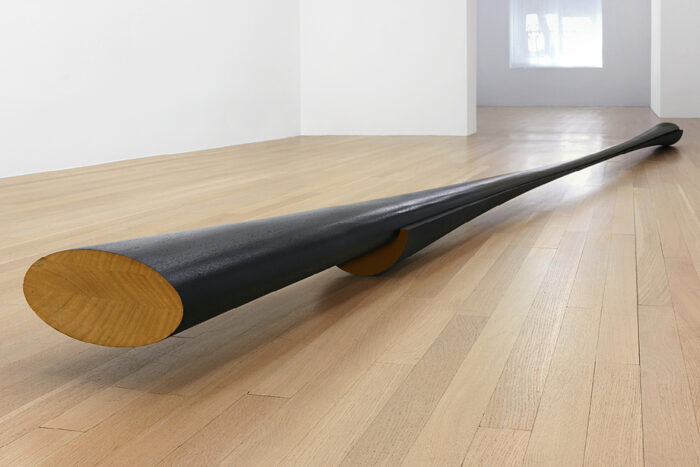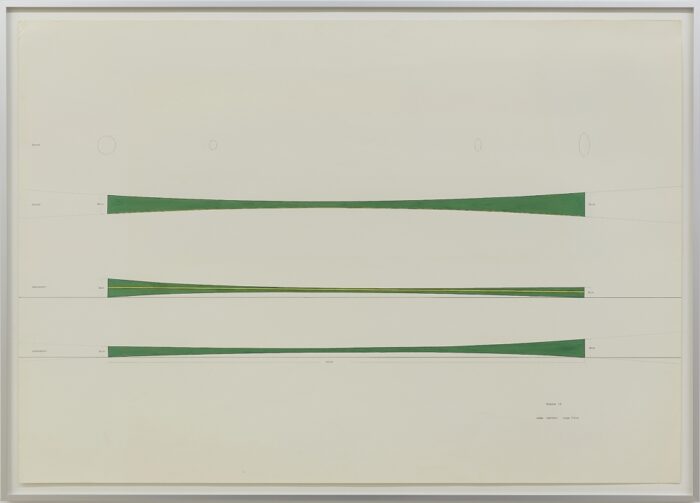
Isa Genzken at Galerie BuchholzIsa
October 28, 2020 – January 30, 2021
All images courtesy of Galerie Bucholz
Isa Genzken, now in her early seventies, is a highly regarded, highly accomplished sculptor based in Berlin. The current show at Galerie Buchholz consists of a single sculpture: Schwarzes Hyperbolo Nuesschen (Black Hyperbolo Little Nut) (1980). It is a long, very low, narrow piece of wood held by an open cradle, also made of wood. The entire length of the sculpture is only a couple of inches off the ground. At the time, Genzken was working with ellipsoid forms generated by computer; Nuesschen, or Little Nut, works particularly well as an example of this body of work. It evidences Genzken’s unusual ability to incorporate a minimalist sensibility in her art, but unlike the work of the artists active in the field in New York, at the time Nuesschen was made and a decade or earlier, Genzken’s piece is less forbidding and closed. It also looks like an extended, narrow tree trunk without branches–the sculpture cannot be linked to minimalism alone and perhaps reflects the German love of nature. At the same time, the work is an elegant piece of modernism, whose slight flair outward, at either end of its length, gives Nuesschen a subtle elegance we can easily associate with a modernist diction.


In later works, Genzken has experimented with such pop images as of Nefertiti wearing sunglasses. My own preference is for the earlier, more formal art she has made. We are currently living in a time when an anti-aesthetic is being promulgated; Genzken, in the piece on exhibit, remains concerned with formal elements that give the work a direct simplicity of shape that is memorable. The interesting thing about this piece is that it represents only a small part of Genzken’s oeuvre, which has changed drastically since the time of Nuesschen’s construction. The other point to be made is that the gallery has decided to do a show of a single piece alone, with the various studies on paper leading up to it. It is a brilliant decision, in the sense that the sculpture is of genuine consequence, and the accompanying preparatory drawings give a real sense of how Genken conceived of the sculpture. In a time when American sculptors are quite literally throwing wood on the floor and calling it art, it is a pleasure to take account of the close consideration Genzken gives to Nuesschen. As it happens, the work consists of a cradle more or less its length, also made of black wood, that closely holds the upper tree-like form. One hesitates to allegorize, but the feeling engendered by this support is one of close alliance and help–as if the form were receiving the bolstering it needed.

The accompanying drawings, a few made on the computer and consisting only of words, demonstrates the care Genzken took in conceptualizing the work of art. There are several extremely beautiful renderings of the sculpture in bright colors. Genzken is not only a formalist; she is also an idiosyncratic conceptual sculptor, so Nuesschen may not be representative of her oeuvre in its entirety. The work possesses an elegance that distances it in some ways from art being made elsewhere. One-piece does not constitute a museum show, but the presentation of the sculpture, along with preparatory works on paper, gives the exhibition an unusual depth and seriousness of purpose. It can be said that women are very well represented in the field of contemporary sculpture: one thinks of Doris Salcedo in Colombia, and Susana Solano in Spain, and Rachel Whiteread in Britain. Genzken in part of this group. This small show emphasizes the extent to which an important woman sculptor devoted an earlier period of her creativity to a formalist exercise that is compelling. Even if we have only one work and its contributory drawings to consider, it is clear she is an artist of outstanding stature.


